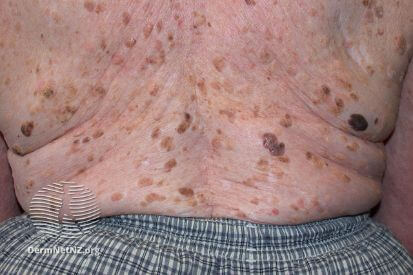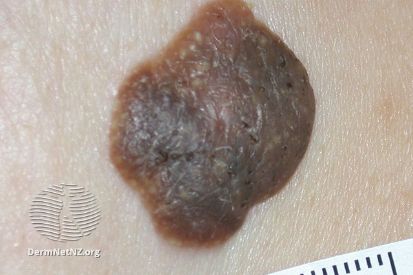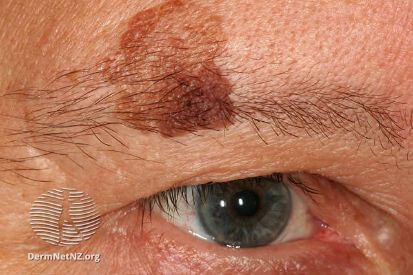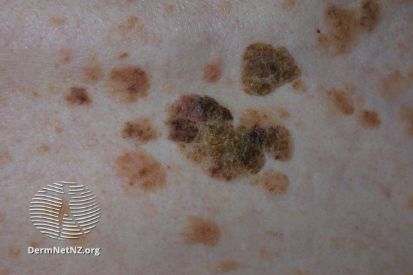Seborrheic Keratosis
Seborrheic keratosis is a common, non-cancerous skin growth that typically presents as brown, black, or yellow lesions, often mistaken for warts due to their appearance. These growths can vary in size, color, and texture, and while generally harmless, they can be cosmetically bothersome. At Pinehurst Dermatology & Mohs Surgery Center, our specialists provide expert evaluation, diagnosis, and personalized treatment options to address both aesthetic concerns and skin health.
Seborrheic keratosis often appears on sun-exposed areas like the face, chest, and back, making it a common concern for those mindful of their skin's appearance. While these growths pose no cancer risk, they can sometimes resemble more serious conditions, so professional evaluation by a dermatology provider is important. At Pinehurst Dermatology & Mohs Surgery Center, we prioritize your peace of mind by offering precise diagnosis and effective treatment options that align with your cosmetic goals and skin needs.
Examples of Seborrheic Keratosis




What is Seborrheic Keratosis?
- Benign growth that typically emerges in brown, black, or yellow tones.
- These lesions, singular or grouped, can appear flat or slightly elevated on the skin.
- They are commonly mistakenly identified as warts due to their resemblance.
Causes of Seborrheic Keratosis:
- Age and Genetics: Seborrheic keratosis is more common with age and tends to run in families.
- Sun Exposure: Prolonged exposure to the sun's ultraviolet (UV) rays may contribute to the development of seborrheic keratosis.
- Friction and Rubbing: Areas subject to frequent friction or rubbing, such as clothing folds, may be more prone to these growths.
- Non-Cancerous Nature: Seborrheic keratosis is a benign skin growth, not associated with cancerous changes.
How to Prevent Seborrheic Keratosis
Sun Protection: Given the potential link between sun exposure and seborrheic keratosis, protecting the skin from harmful UV rays is crucial. Regular use of sunscreen with adequate sun protection factor (SPF) and wearing protective clothing can mitigate the impact of ultraviolet radiation.
Hygiene and Skincare: Maintaining good skincare practices can be beneficial such as gentle cleansing routines, moisturizing, and regular dermatologist visits.
Genetic Awareness: Since there is a familial predisposition to seborrheic keratosis, individuals with a family history should remain vigilant. Regular skin checks and early consultation with one of our dermatologists can aid in timely detection and management.
Healthy Lifestyle: Embracing a healthy lifestyle with a balanced diet, regular exercise, and avoiding tobacco can promote overall well-being, potentially influencing skin health.
While these measures may support skin health, seborrheic keratosis remains challenging to prevent entirely, as genetic factors and aging are significant contributors. Regular at-home skin checks, annual Total Body Skin Exams, and bringing attention to any suspicious growths are crucial for early detection and treatment.
Seborrheic Keratosis FAQs
No, seborrheic keratoses are benign and not harmful. However, they can sometimes be mistaken for more serious conditions, so it's important to get them checked by a dermatology provider.
No, seborrheic keratosis is not related to skin cancer. However, because they can sometimes resemble cancerous lesions, it's important to have any new or changing growths evaluated by a dermatology provider.
Having multiple seborrheic keratoses is common, especially as you age. However, if you notice rapid changes in number or appearance, it's best to consult a dermatologist.
You should see a dermatologist if you notice any new or changing skin growths, if a seborrheic keratosis becomes irritated or painful, or if you wish to have one removed for cosmetic reasons.
How to Treat Seborrheic Keratosis
If a seborrheic keratosis becomes irritated or unsightly, removal is conducted using one of these three methods:
- Cryosurgery: freezes off the growth using liquid nitrogen.
- Curettage: the dermatologist scrapes the growth off the surface of the skin.
- Electrocautery: used alone or in conjunction with curettage to burn off the tissue and stop the bleeding.
Featured Products for Seborrheic Keratosis

Revision Gentle Foaming Cleanser
Revision Gentle Foaming Cleanser is a soap-free cleanser that comforts and moisturizes all skin types. 5 fl oz / 150 mL

SkinMedica HA5 Rejuvenating Hydrator
Provides immediate smoothing in the appearance of fine lines and wrinkles, and supports the skin's natural ability to replenish its own hyaluronic acid for overall skin health. Appropriate for all skin types. 2 fl oz / 56.7 mL
